A Private Tour today. It was a cold and misty start – always a problem with easterly winds at this time of year. But it brightened up a little by the afternoon.
We started at Titchwell. A quick walk around the overflow car park produced a little group of five Bullfinches feeding on buds in the bushes, their quiet piping calls gave their presence away. A small olive-green bird flicked around in the brambles – a Chiffchaff. We watched it flycatching, though it may have struggled to find any flies in the chilly temperatures. There has been one around the reserve all winter, but this was not the only one we saw today, so some will presumably have been early migrants on their way back north.
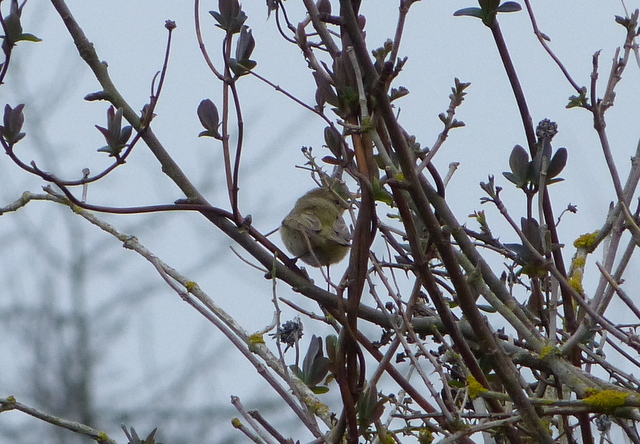 Chiffchaff – the first of several today, some will have been early migrants
Chiffchaff – the first of several today, some will have been early migrants
We set out onto the reserve. The Thornham grazing marsh pool is now looking very dry and rather birdless. However, we stopped to look along one of the channels in the reedbed and a pair of Red-crested Pochard swam briefly out from the edge. Nearby, on the reedbed pool were another three – we got one smart male in the scope, admiring its bright orange punk haircut and pinkish-red bill. There were even more on the freshmarsh when we got there later, at least seven, but hard to know if there was any double counting.
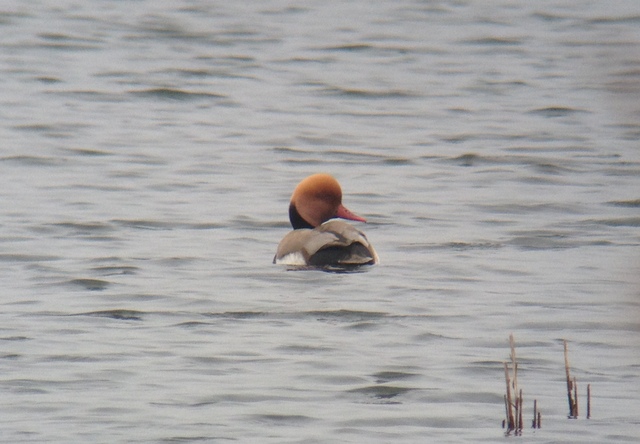 Red-crested Pochard – check out that haircut
Red-crested Pochard – check out that haircut
While we were scanning the reedbed, two birds flitting around in the reeds by the pool turned out to be two more Chiffchaffs. The Cetti’s Warblers were singing loudly in the scrub.
The large flock of Brent Geese had been flushed from their favourite field in front of Titchwell Manor hotel as we set off – presumably the farmer objects to having his winter wheat ‘mown’! They were all still out on the freshmarsh when we got there. We could hear the chattering as we walked out.
We made our way round to Parrinder Hide. The water levels on the freshmarsh are finally starting to recede and there were a few more waders today – the reappearance of the tops of the islands means they don’t have to get their feet quite so wet! There were a couple of little groups of Dunlin and a small flock of Knot flew in to join them, along with a Grey Plover and a handful of Turnstone. We got a good look at both Bar-tailed and Black-tailed Godwit – a great opportunity to look at the differences between these two similar species. And the Avocets were looking a bit happier, now the islands have reappeared!
 Avocet – feeding in the channel on Volunteer Marsh
Avocet – feeding in the channel on Volunteer Marsh
There was still a good selection of ducks to see. As well as the Red-crested Pochards, there were still good numbers of Common Pochard and Tufted Duck, and a couple of Goldeneye. The dabbling ducks were well represented as usual, with lots of Teal, a few Wigeon, plenty of Gadwall today, Mallard and Shoveler. The drakes are all looking very smart at the moment, in their spring best.
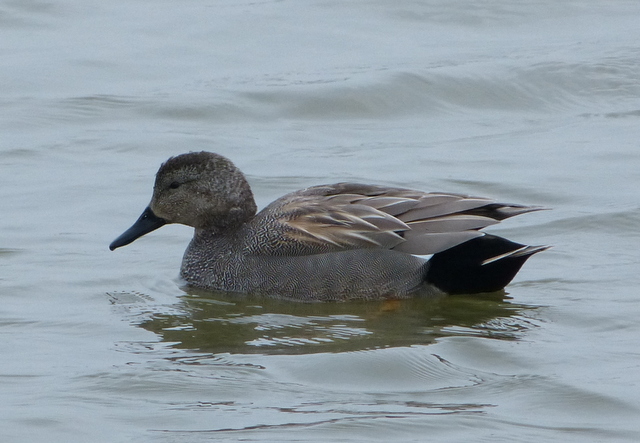 Gadwall – a smart drake, a subtle and under-rated bird
Gadwall – a smart drake, a subtle and under-rated bird
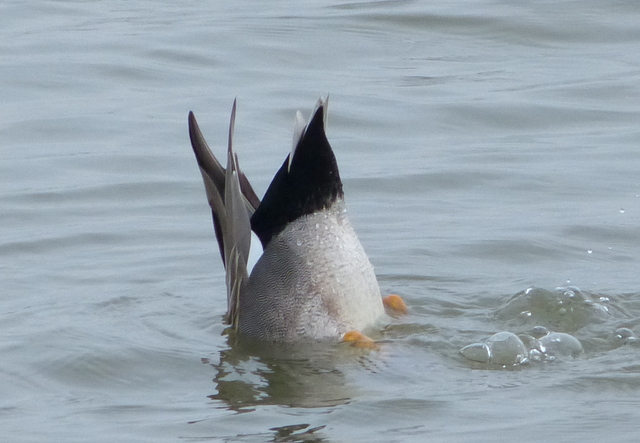 Gadwall – an alternative view!
Gadwall – an alternative view!
While we were looking out at the freshmarsh, the smaller waders suddenly took to the air. A Peregrine was circling behind the hide, over the Volunteer Marsh, before drifting away. We picked it up again later, perched on the concrete bunker out across the saltmarsh, where it stayed for the rest of the morning. Needless to say, when we had a look at the Volunteer Marsh shortly after, most of the waders had all disappeared. However, we did find a rather nice Grey Plover feeding on the mud near the bank.
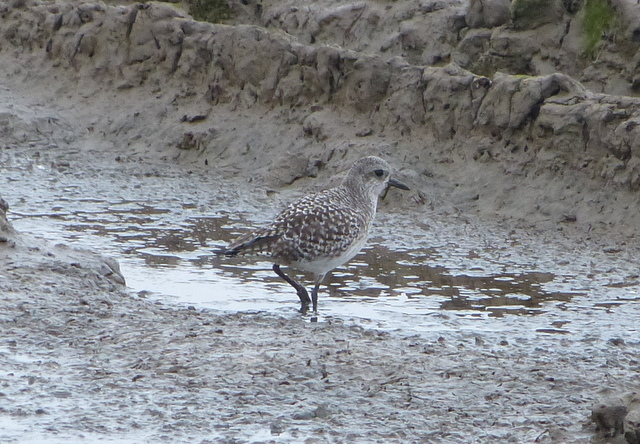 Grey Plover – the one not flushed by the Peregrine
Grey Plover – the one not flushed by the Peregrine
As we walked back from the hide, a call overhead alerted us to a Marsh Harrier displaying. We watched it tumbling high above us, with buoyant flappy wingbeats. It drifted out over Thornham Marsh, before dropping down into the reedbed. We had also seen the Marsh Harriers in the main reedbed collecting nesting material on our way out – the breeding season for the harriers at least is a ‘go’!
A few birds had dropped back to feed on the edge of Volunteer Marsh nearest the main path. We stopped to watch a little group of Teal feeding – a couple were in the water, sweeping their bills backwards and forwards across the surface, and another two were doing the same on the mud.
 Teal – feeding on the edge of Volunteer Marsh
Teal – feeding on the edge of Volunteer Marsh
On the tidal pools, we added Pintail to the day’s list. We admired a really smart drake and his long pin-shaped tail projection and several ducks. The tide was in, so more waders were huddled together here – lots of Oystercatcher, Bar-tailed Godwit and Knot. We walked out onto the beach briefly, but it was cold in the wind and very misty just offshore. There were a few Red-breasted Mergansers on the sea still, just close enough to see, but few waders. We didn’t hang around long and set off back to the car.
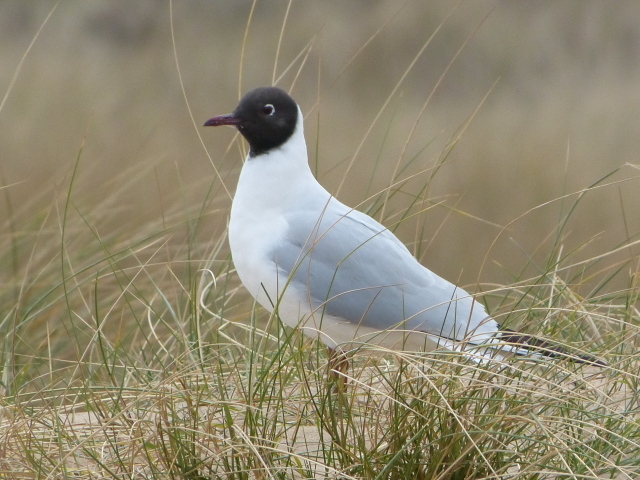 Black-headed Gull – begging from someone else today
Black-headed Gull – begging from someone else today
We had a particular request to see Brown Hares. They had been lying low in the fields before we started today. The weather was starting to brighten a little now, so we had a drive round the back of Titchwell village. There was certainly no shortage of Hares – 15 in one field, 12 in another, etc, etc. But there was still very little activity and most were huddled down. The sun popped out briefly while we explored inland – just long enough for two Hares to chase each other round and fists to be raised, but the hoped for bout of boxing did not happen.
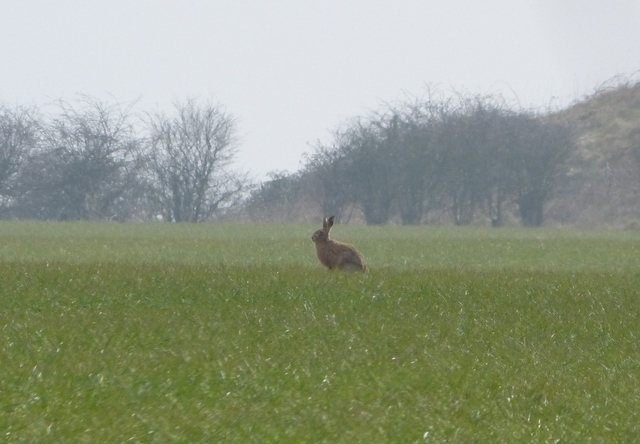 Brown Hare – most were lying low in the fields today
Brown Hare – most were lying low in the fields today
We stopped to admire a male Yellowhammer perched on some overhead wires. Unfortunately, a Corn Bunting wasn’t quite so accommodating and flew straight over without stopping.
Our next stop was Holkham. There were still lots of Fieldfares out on the grazing meadows by Lady Anne’s Drive, waiting for warmer weather before heading over the sea back to Scandinavia. We walked west on the inland side of the pines. It was nicely sheltered from the wind and the sun was finally starting to break through the mist. The Goldcrests were taking advantage and feeding in the brightness, low down in the young Holm Oaks along the path. There was also a good selection of tits, and several Treecreepers on the edge of the pines.
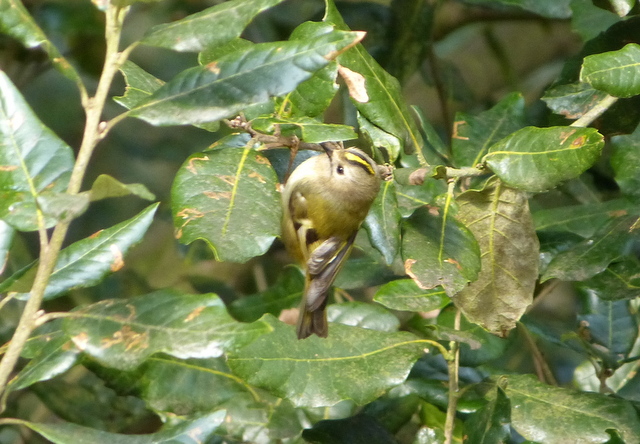 Goldcrest – lots were feeding along the path
Goldcrest – lots were feeding along the path
We stopped at the Joe Jordan hide and it didn’t take long to spot a Spoonbill flying out of the trees and down to the nearby pool. Unfortunately, the flip-side of the sun coming out was that we were now looking directly into it. But we watched the Spoonbill wrestling a stick out of the water before flying back up into the trees with it – nest building has started for the Spoonbills too. A little later, the same bird or a second did exactly the same thing.
 Spoonbill – collecting nest material
Spoonbill – collecting nest material
There were also lots of Marsh Harriers to look at, circling over the marshes. A Common Buzzard was feeding on a kill, and one Marsh Harrier in particular clearly had its eye on it – standing patiently nearby. Amongst the resident feral Greylag, Canada and Egyptian Geese we also found a few lingering White-fronted Geese. They are only with us for the winter, but are yet to set off back to Russia – unlike the Pink-footed Geese which have already mostly departed on their way back to Iceland.
Walking up into the edge of the dunes, we struggled to find our final target for the day at first. It was particularly difficult looking out across the grazing marshes, into the sun and remains of the mist. Eventually, a shape materialised distantly out on the grass – its pale head and contrasting blackish belly patch immediately gave it away. The Rough-legged Buzzard was still present, but it wasn’t the best of views. Thankfully, a Carrion Crow landed nearby and came over to annoy it. The Rough-legged Buzzard eventually took umbrage and flew off, with several Crows in pursuit. It circled out over the dunes, flashing its black-banded white tail, and finally shaking off its pursuers, before flying back out over the marshes. It landed a little closer and we had a last look at it through the scope before heading back to the car. A good bird to end the day.
















